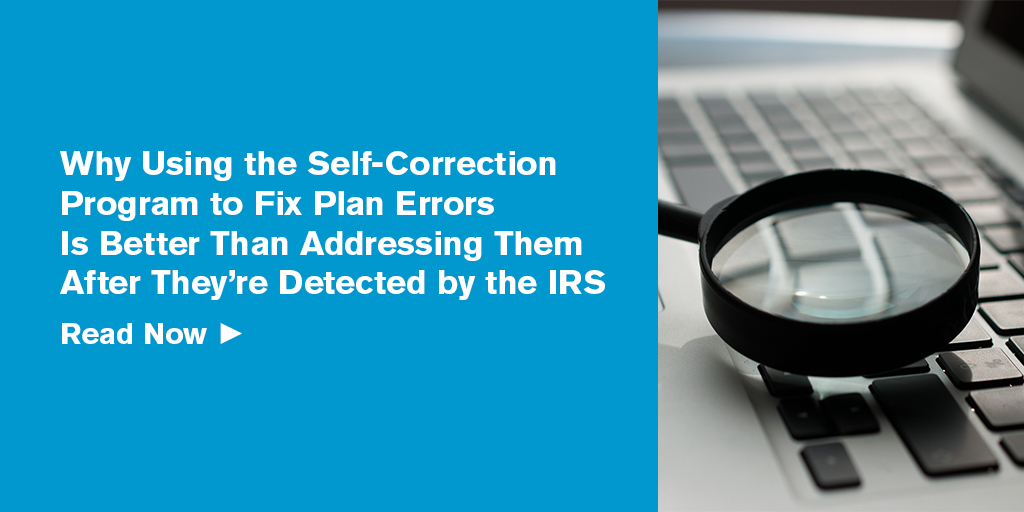If your plan offers participants a plan loan option and you’re not infallible, here’s some good news: A recent IRS Revenue Procedure allows plan sponsors to jump through fewer hoops to fix several so-called “plan failures” relating to plan loans.
Specifically, plan sponsors can now fix more categories of loan glitches using the streamlined Self-Correction Program (SCP) under the IRS’s umbrella Employee Plans Compliance Resolution System, instead of the more burdensome Voluntary Correction Program (VCP).
SCP and VCP Fixes
Under the SCP, you can fix certain plan failures on your own without having to deal with the IRS or pay any fees. The program is intended to correct “operational errors,” meaning you didn’t follow the terms of your plan.
The VCP, program, in contrast, involves sending the IRS an explanation of the error you’ll be correcting along with a fee in the $1,500 to $3,500 range, depending on the size of your plan. You’ll also need to explain how you intend to correct the error. You then must wait until the IRS accepts your proposed fix before you’re back in its good graces.
“Insignificant” Errors
The SCP is an option for errors that the IRS considers “insignificant.” However, it also includes errors considered significant if you correct them by the end of the second year following the plan year in which the error occurred. One category of error that is automatically classified as “significant” involves plan document failures, meaning noncompliant provisions within your plan document.
In contrast, IRS Revenue Procedure 2019-19 covers administrative errors, such as plan loan mistakes. For example, using the SCP, instead of the previously required more time-consuming and costly VCP method, plan sponsors can now self-correct mistakes involving:
-
Loans exceeding the $50,000 ceiling,
-
Loans with payment schedules beyond the five-year maximum payback period (longer periods are possible if the loan is used to buy a primary residence), and
-
Failure to properly address plan loan defaults.
In all three scenarios, unless you’re able to make the necessary correction in time, you must report that the plan participant has received a “deemed distribution.” The amount of money involved then becomes taxable.
Steps to Correction
Rev. Proc. 2019-19 spells out the specific steps you need to take to fix the problems to be eligible for the SCP approach. For example, fixing a loan exceeding the $50,000 cap can be addressed if the excess amount is promptly repaid. That’s simple enough, but the revenue procedure spells out three ways that loan payments ― made before your realizing the amount borrowed exceeded the limit ― are applied to reducing the excess principal.
When the loan period exceeds the five-year limit, fixing it in a way that lets you use the SCP involves re-amortizing the loan “over the remaining period of the proper payment period measured from the original date of the loan,” according to the IRS. Thus, for example, if you discovered that a loan was set up with a six-year amortization schedule instead of the maximum of five years, and you make that discovery two years after the loan was made, you’d need to re-amortize the loan so that it’s paid off in three years (bringing the total to five) instead of four.
Make the Fix
Using the SCP to fix plan errors is better that addressing them after they’re detected by the IRS in an audit. The agency prefers that you identify your own mistakes and come clean. Check with your plan administrator to ensure that new procedures are put in place to allow you to take advantage of the more liberal self-correction procedures. As with all ERISA rules, the devil is in the details.
 If your plan offers participants a plan loan option and you’re not infallible, here’s some good news: A recent IRS Revenue Procedure allows plan sponsors to jump through fewer hoops to fix several so-called “plan failures” relating to plan loans.
If your plan offers participants a plan loan option and you’re not infallible, here’s some good news: A recent IRS Revenue Procedure allows plan sponsors to jump through fewer hoops to fix several so-called “plan failures” relating to plan loans.

